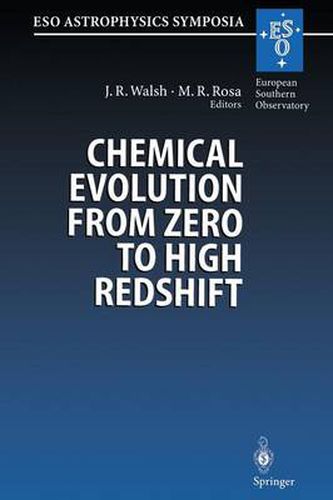Readings Newsletter
Become a Readings Member to make your shopping experience even easier.
Sign in or sign up for free!
You’re not far away from qualifying for FREE standard shipping within Australia
You’ve qualified for FREE standard shipping within Australia
The cart is loading…






This title is printed to order. This book may have been self-published. If so, we cannot guarantee the quality of the content. In the main most books will have gone through the editing process however some may not. We therefore suggest that you be aware of this before ordering this book. If in doubt check either the author or publisher’s details as we are unable to accept any returns unless they are faulty. Please contact us if you have any questions.
With the new era of 8-10 m telescopes the power to spectroscopically examine the light of fainter and more distant targets has taken a ‘photon’ leap. It is now becoming routinely possible to obtain high signal-to-noise spectra of very distant objects and to attempt the determination of their abundances. The motivation for a workshop on this topic could be summarized thus: Do we understand enough about chemical abundances at zero redshift to trust any conclusions on chem- ical evolution at high redshift? Given our observational background in gaseous nebulae, we thought at first in terms of a workshop largcly devoted to the inter- stellar medium. However, we were encouraged by Jacqueline Bergeron and Alvio Renzini to pitch the theme much wider. The members of the Scientific Organiz- ing Committee (Francoise Combes, Don Garnett, Guinevere Kauffmann, Claus Leitherer, Danny Lennon, Max Pettini, Peter Shaver, Elena Terlevich and David Tytler), under the chair of John Mathis, made sure that we kept the conference broad in scope. We thank them for their encouragement and advice. Informally the working title for the conference thus became High and low Z from low to high z (or Z@O
$9.00 standard shipping within Australia
FREE standard shipping within Australia for orders over $100.00
Express & International shipping calculated at checkout
This title is printed to order. This book may have been self-published. If so, we cannot guarantee the quality of the content. In the main most books will have gone through the editing process however some may not. We therefore suggest that you be aware of this before ordering this book. If in doubt check either the author or publisher’s details as we are unable to accept any returns unless they are faulty. Please contact us if you have any questions.
With the new era of 8-10 m telescopes the power to spectroscopically examine the light of fainter and more distant targets has taken a ‘photon’ leap. It is now becoming routinely possible to obtain high signal-to-noise spectra of very distant objects and to attempt the determination of their abundances. The motivation for a workshop on this topic could be summarized thus: Do we understand enough about chemical abundances at zero redshift to trust any conclusions on chem- ical evolution at high redshift? Given our observational background in gaseous nebulae, we thought at first in terms of a workshop largcly devoted to the inter- stellar medium. However, we were encouraged by Jacqueline Bergeron and Alvio Renzini to pitch the theme much wider. The members of the Scientific Organiz- ing Committee (Francoise Combes, Don Garnett, Guinevere Kauffmann, Claus Leitherer, Danny Lennon, Max Pettini, Peter Shaver, Elena Terlevich and David Tytler), under the chair of John Mathis, made sure that we kept the conference broad in scope. We thank them for their encouragement and advice. Informally the working title for the conference thus became High and low Z from low to high z (or Z@O